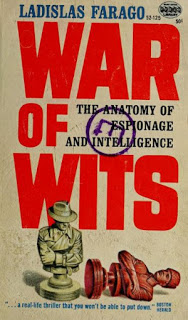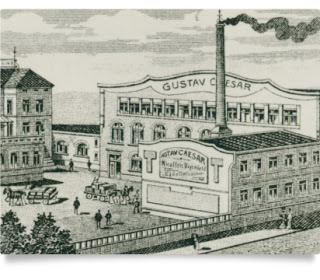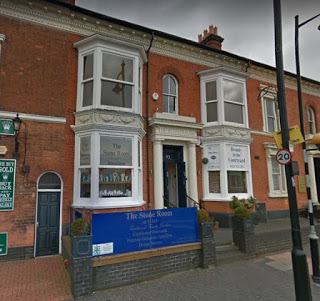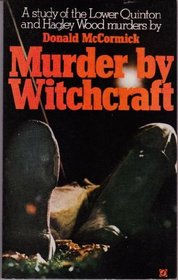Was there a war-time spy ring in Birmingham, England? It’s a topic that comes up quite frequently in the Bella in the Wych Elm story. The theory is that Bella was involved with the Birmingham spy ring, ran afoul of the leaders and ended up stuffed in the hollow wych elm. To date, however, I’ve never come across any solid evidence to support that particular theory. I was always perplexed as to where the theory originated, and had only ever come across it in Donald McCormick’s book, Murder by Witchcraft.
Donald McCormick – Murder by Witchcraft – 1968
I blogged about his book in regards to the Bella case back in May 2017. McCormick told the tale of a stellar spy operating in the British Midlands…
My next search was into any records which showed whether the Germans had successfully infiltrated their spies into the Midlands during the war. This proved both lengthy and in the main unrewarding. This was quite understandable in that what I was looking for was almost certainly something which the British authorities themselves had not uncovered. During World War II a German spy, never positively identified, carried out a remarkable number of coups in Britain over a long period. He delivered to the Germans a top-secret report prepared by Sir Alexander Cadogan, then Permanent Under-Secretary of Foreign Affairs, a dossier of maps showing the emergency system of food and fuel distribution in Britain, information about the deficient defences at Scapa Flow which led to the penetration of that naval base by the U-47 and the sinking of the Royal Oak, blueprints of British docks and maps of air-fields as well as a complete report on the organisation of shadow factories around Birmingham and Coventry. But who was this mysterious spy who evaded capture? He was still active in 1944. One suggestion from the German side after the war was that he was a German-Canadian named Karl Dickenhoff, who lived in a house at Edgbaston. Dickenhoff also had many aliases , but his real name was said to be Hans Caesar and is believed to be still alive. (p.157-158)
Whether Hans Caesar, alias Dickenhoff, was the ace spy or not matters very little now. But it is known that he was an associate of a Dutchman named Jan Willem Ter Braak, who, according to Frau Cremer, was a friend of ‘Clara’ alias Dronkers. The Dutchman was found dead in a deserted air raid shelter in Cambridge, with a bullet in his brain and a German revolver by his side. In his lodgings were found false papers and a German-manufactured radio transmitter. (p. 158)
McCormick’s research has long been called into question, but I am impressed at how he managed to weave the ace spy, Hans Caesar, together with Ter Braak and the non-existent ‘Clara’ Dronkers… McCormick’s book is an example of how a few rumours can be expanded into a readable, although highly inaccurate story.
Ladislas Farago – War of Wits – 1954

The core of McCormick’s story, published in 1968, seems to be Ladislas Farago’s book, War of Wits, published in 1954. Farago, too, seemed to have relied upon a creative embellishment of the facts when writing his books. Part of the problem lies in the fact that the British were still keeping word of their double-cross system and their breaking of the German wartime code under wraps. And in order to explain how they managed to have such accurate information… certain other explanations were put out there: that the British had an agent on the German General Staff… that Admiral Canaris had visited Stewart Menzies (MI6) or even Churchill during the war. Any book written prior to the revelation of the double cross system and Britain’s breaking of the German code do not have the whole picture… and tend to try to put the pieces together with creative (and often imaginary) connectors.
In War of Wits, Farago rattles off a number of stories, all of which are built on shaky ground:
While Britain succeeded in unmasking most of the German agents of World War II, one truly effective spy managed to evade the net. The man succeeded in outwitting Britain’s entire counter-espionage machinery for seven years, from 1937, when he entered Britain allegedly from Canada, to 1944, when his trail eventually vanished. During those seven years, this phantom spy supplied the German secret service with a remarkable collection of intelligence. Among his deliveries were (paraphrased):
-
- report by Sir Alexander Cadogan
- dossier of maps about food and fuel distribution
- defences of Scapa Flow naval base
- blueprints of docks in London and Hull
- maps of Kent airfields – “Later, this phantom spy was sad to have directed the Luftwaffe raids on these airfields in preparation for the Battle of Britain”
- report on industries in Birmingham and Coventry – The spy was credited with the guiding of the German bombers to these crucial targets”.
This is only a partial list of the man’s achievements. His activities still baffle British counterespionage and even such a taciturn spy-catcher as Colonel Hinchley Cook of MI-5 pays an unstinted tribute, if not to the efficiency of the German secret service, then to the competence of this one agent. Who was this formidable adversary? How could he remain undetected? How could he escape?
Even today, no one professes to know the answers to these questions. Some say that all these scoops were scored by a single operative, probably one of the greatest spies who ever lived. Others presume that there were, in fact, three different men behind these coups, none of whom was ever caught. Still others insist that they were the work of a brilliant network of Germany’s ace operatives led by a single genius who not only understood how to direct his men but also how to protect them from the spy-catchers.
Whoever he was, this phantom was still going strong in the fifth year of the war, on the very eve of the Normandy invasion. When, in March, 1944, General Eisenhower moved his headquarters from London to Busy Park to evade German spies, the phantom reported the transfer to Berlin within 72 hours. Later, he reported the exact date of D-Day, but Hitler trusted his intuition more than a report from his master spy. He simply refused to believe that the Allies would have the audacity to invade his continent.
It may be that this elusive Scarlet Pimpernel was someone whom MI-5 and Scotland Yard did meet, but only as a corpse, in a deserted air-raid shelter in Cambridge, with a bullet in his head and a German revolver at his side, apparently a suicide. From the paper in his pocket he was identified as a native of Holland, Jan Willem Ter Braak, but it was obvious that this was an alias. Later the body was recognized by a landlady who reported one of her boarders missing. In Ter Braak’s abandoned room, the spy-catchers found forged documents and a powerful German-made radio transmitter.
However, it is more likely that the phantom spy was a German-Canadian who called himself Karl Dickenhoff. He lived quietly in a villa in Edgbaston. His real name was Hans Caesar. His is a weird story, somewhat in the Conan Doyle tradition. Caesar is said to be still alive and in England, the demented, amnesia-stricken inmate of an insane asylum. Nobody will say whether he is really unbalanced or merely simulates insanity to escape the consequences of his wartime activities.
I really don’t know where to start in dismantling Farago’s story but for starters, Ter Braak was found in the air raid shelter in April 1941 so clearly he could not have been the mystery agent who supposedly operated until 1944. And it is highly doubtful that Hinchley Cook gave Farago any hint of information. But let’s focus on Farago’s last comment, that the phantom spy was “likely” a German Canadian who called himself Karl Dickenhoff but whose real name if Hans Caesar. This is pretty specific information and would seem to be based on fact. But how much is fact… and how much is fiction? And where did the story originate?
Pete and Alex Merrill, currently working on their second volume in the Bella mystery, kindly sent me some post-war newspaper clippings from the Birmingham area which shed some light on the origin of the Hans Caesar story.
Evening Despatch – 13 June 1945
On 13 June, 1945, the Evening Despatch had a splashy spread which trumpeted that a German Jeweller from Hockley had led the Blitz on Birmingham.
Nephew of spy of the last war was Nazi agent
German Jeweller from Hockley led Blitz on Birmingham
[You can blame Hans for this – image of bombed out building]
He pinpointed raids on Midland “Hatton Garden”

A remarkable story of how a German jeweller from Hockley, nephew of a spy of the first great war, led the German blitzes on Birmingham is revealed in the British Jeweller, the monthly publication of the Birmingham Jewellers’ and Silversmiths’ Association.
This German agent, it is stated, used his intimate knowledge of the district to direct pinpoint attacks on Birmingham’s “Hatton Garden”.
He was Hans Caesar, and members of the jewellery trade remember him as a plausible young man, who re-established his uncle’s business as a dealer in semi-precious stones. Just before the outbreak of the war he returned to Germany, and it subsequently transpired that he had been trained by the Nazis.
The author of the article in the British Jeweller is W. Stewart-Turner.
Writing on “The German Menace,” he states that the question for the jewellery trade to decide is: “Are we going to buy from Germany again?”
“At this moment, following the dreadful disclosures of the concentration camps, it is likely that most people would say: ‘Never again can we deal with them.’ But when they come along with goods attractive and cheap, made by labour existing on a much lower standard than that which we hope to maintain here, the temptation will be to say: ‘Well, if I don’t buy from them others will.”
“It would seem to be a matter for concerted action, as in all probability if the wholesalers refuse to handle the goods they may go to the retailer.
“It should be remembered that the German stone dealer, Hans Caesar, who resided in Birmingham for seven or eight years, was a Nazi agent, and used his knowledge of the district to lead a bombing attack on Birmingham in which the jewellery district was badly damaged.
“On their radio the announcer boasted that the signal accuracy of the bombing was due largely to the work of their good friend Caesar, who knew the city and its environs in the greatest detail.
“The uncle of this man was also a stone dealer in Birmingham before the 1914-1918 war, and left with half-a-dozen other Germans just previously to the outbreak of the first war, no doubt well-informed with the knowledge of our munition and armaments industries.
“Otto Block, another agent of that period, had openly boasted of their war-like intention toward this country.”
Girl Heard Broadcast
A prominent member of the Birmingham jewellery trade interviewed by an Evening Despatch representative, said that the first contact with the story of the blitz led by Hans Caesar was when a girl in the trade picked up a German broadcast at 7:30 one morning and heard the announcer boasting about the bombing of Birmingham and the work of “their good friend Caesar”.
“The story of Caesar goes back to a former generation,” the merchant said. “Caesar’s uncle dealt in stones from premises in Vyse-street. Towards the end of July, 1914, he, together with a number of other Germans, decided to go on their holiday.
“Of course, they had been recalled.
“It should be explained that the stones in which these men dealt are what are known as semi-precious stones. The diamond trade (precious stones) is located mainly at Amsterdam and Antwerp, but the Germans have practically the monopoly of the semi-precious stones industry which was established at Idar Oberstein in the Black Forest.
Just like Uncle in 1914
“The English dealers were almost bound to buy stones from the Germans, in spite of the fact that the raw material comes from the British Empire.
“Two or three years after the end of the first war, the nephew, Hans Caesar, comes on the scene and re-establishes the business carried on by his uncle in the same building.
“He was a very plausible young man.
“He lived in Edgbaston; he was a member of the Navy League; and he used to go around in a car with a cine-camera. It appeared afterwards that he had been trained by the Nazis.
“He would sympathise with the Jews at one moment; and then would go round to a non-Jewish firm and boast about it.
“Just before the outbreak of the war, in September, 1939, he wound up his business and went back to Germany, just like his uncle did in 1914.
“I am told on good authority that Hans Caesar met his end on the Eastern Front.” (Evening Despatch 13 June 1945)
The story in the Evening Despatch seems to be based on an article written by C. Stewart-Turner for the British Jeweller and the key bit of information from that article would seem to be that a girl in the jewellery business heard a German broadcast in which the announcer boasted that the bombing of Birmingham was the work of “their good friend Caesar”. Out of that flimsy bit of information, Stewart-Turner spun quite a story about Caesar and his uncle. One could wonder if perhaps Stewart-Turner had another motive in undermining the credibility of the German jewellers. Eliminating the Germans as competition would likely have a salubrious effect on the British jewellery industry. The Evening Despatch doesn’t mention when the British Jeweller article was published but the Birmingham Library does have copies of the magazine.
The next mention of Hans Caesar occurs ten years later, after the publication of Farago’s book, which caused quite a stir and reignited the story.
Birmingham Post – 3 April 1956
The Birmingham Post took Farago’s book and ran with it…
The Spying Caesar of Edgbaston
An Account of War-time Activity
Remarkable exploits are attributed in a new book published today* [*War of Wits, by Ladislas Farago (Hutchinson, 18s.)] to a German spy who “lived quietly in a villa in Edgbaston.” His name was Hans Caesar and, according to the author, who was four years with the United States Governmental Intelligence service, he escaped capture and is said to be still in England in an asylum, though “nobody will say whether he is really unbalanced or merely simulates insanity to escape the consequences of his war-time activities.”
Caesar, who, says Mr. Farago, outwitted the British counter espionage service for seven years, is credited with getting out of the country:–
– A secret document, of which only four copies existed, setting out the Foreign Office’s estimate of Anglo-German relations.
– Maps showing the emergency system of food and fuel distribution in the United Kingdom.
– Information about the defences of Scapa Flow which enabled the U-47 to enter the base and sink the Royal Oak.
– Blue prints and maps of London and Hull docks.
– Maps of the airfields in Kent built to defend London from air attacks, which Caesar later directed.
– A report on the dispersal of industries and the organisation of shadow factories around Birmingham and Coventry. Caesar is also said to have guided German bombers to these targets.
A Keen Photographer
Caesar was a German-Canadian. He also called himself Hans Dickenhof [sic] and was well-known in the Birmingham jewellery trade for seven or eight years before the war. An article which appeared in The British Jeweller in March, 1941, described him as of pleasant personality and impressive physique and a friend and confidant of many people in the jewellery trade.
“He ran a large car and, it is said, spent far more money than his circumstances appeared to warrant… He also had a cine camera which he used a great deal. He made frequent trips to Germany and for many German dealers who came to this country his office was a rendezvous.”
The article added that some time before the outbreak of the war, Caesar announced that business no longer justified his staying and he returned to Germany. Nothing was heard of him for a year and a half and then one morning people listening to the 7.30 broadcast in English from Munich heard “a swaggering reference to the damaging air raids on Birmingham.” Their success the announcer said, and the signal accuracy of their bombing of military objectives, was due largely to the good work of their good friend Caesar, who led the main attack and knew the city and its environs in the greatest detail.
Official Doubts
Mr. Farago also credits Caesar with reporting to Berlin the transfer of Eisenhower’s headquarters from London to Bushey Park within 72 hours of its happening and the exact “D” day, which, he says, Hitler refused to believe.
Official quarters in Birmingham discount most of what is attributed to Caesar in this book. Their belief is that he left for Germany in July, 1939, and never returned to this country. He was later variously reported to have been shot down over Germany and to have served on the Russian front.
This article provides a bit more information on the original British Jeweller article which starts the trail of Hans Caesar. According to the Birmingham Post, the Stewart-Turner article was published in March 1941. According to the article, Hans Caesar left Britain before the start of the war (likely summer 1939) and the radio announcement was heard a year and a half later (likely late 1940/early 1941). This timeline would make sense given the heavy bombing raids on Birmingham in late 1940. But all of this information is essentially pure speculation based on one girl stating that she heard a German broadcaster mention the name “Caesar” in relation to the bombings in Birmingham. Who was this woman? Why was she listening to a German broadcast? Good question… no answers…
But the Birmingham Post would soon find that publishing unsubstantiated allegations could get them into trouble. While the Evening Despatch article was published a month after the war ended and probably didn’t make a wide ripples… the Birmingham Post article caused quite a splash.
Birmingham Post – 19 May 1956 – Apology
Hans Caesar of Edgbaston
An Apology
In our issue for April 3, 1956, we published an article under the heading “The Spying Caesar of Edgbaston.” The article referred to a book by Ladislas Farago called War of Wits and stated that in it the author asserted that one Hans Caesar who it was alleged was well known in the jewellery trade and had lived in Edgbaston for seven or eight years before the last war had both before and during the war been engaged in espionage in this country on behalf of the Germans and had amongst his activities directed the German air-raids on Birmingham and Coventry. It was further suggested that Hans Caesar was in an asylum in England but that no one could say whether he was really unbalanced or was merely simulating insanity in order to escape the consequences of his war-time activities.
We have now learnt that our article has been widely understood to refer to a Mr. Hans Caesar who did live before the war in Edgbaston, and was and still is a well-known figure in the jewellery trade both in the United Kingdom and internationally and who has in recent years resumed his business connections with this country and in particular in Birmingham.
We hasten to say that Mr. Hans Caesar has drawn our attention to the fact that he has never at any time been engaged upon, or has anything to do, with espionage or for that matter with the Luftwaffe. He spent most of the war in the German infantry on the Russian front where he was eventually captured and was not repatriated by the Russians until the end of the year 1949. He is not and never has been in an asylum and his sanity and mental balance have never been in question. Further he has asked us to state that he has never engaged either in this country or anywhere else in any form of activity for which he might be visited with penal consequences.
We desire to tender to Mr. Hans Caesar our sincere apologies for having given circulation to these false and damaging statements concerning him and to express our deep regret for the inconvenience and distress which we recognise the article must have cause him.
Ouch. It would seem that Hans Caesar was a real person, still very much alive, and not willing to have his reputation besmirched by speculation and rumour! One could wonder if Hans Caesar also wrote a scathing letter to Ladislas Farago… but I haven’t found any indication of such a censure. I did, however, find quite a bit of information about the Caesar family business…
Gustav Caesar GmbH

In 1840, one Peter Wilhelm Gustav Caesar in (son of Christian Karl) travelled to Leipzig to a gemstone expo and started a business dealing in semi-precious stones. In 1894, upon his death, one of his sons, Otto Caesar (born 1849) took over the company. Otto was married to Karoline Schmitz from Birkenfeld and the couple had eleven children. Otto, passed away in 1900 at the relatively young age of 51, and the company was subsequently directed by his wife and three of their sons Ernst, Paul Otto and Gustav Georg.
Otto’s sister, Anna Frederica (born 1853), had married an August Caesar Demeaux (born in Germany), and the couple had moved to London in the mid 1870s where they developed some very good business connections amongst the jewellery community. Through her, the Gustav Caesar company enjoyed a very good relationships with English businesses and even opened a branch office in Birmingham, which, after the death of Otto Caesar was overseen by his son Gustav Georg Caesar [this is the uncle referred to in the newspaper articles above]. It would appear that August Caesar Demeaux was also a jeweller (precious stones) and operating in Birmingham at 41 Vyse Street (1878), 39 Vyse Street (in 1892), 93 Vyse Street (in 1912 and 1921). The Gustav Caesar business was also operating out of 93 Vyse Street in 1912 and 1937. This was the same street mentioned in the newspaper article above.

Gustav Caesar’s brother, Paul Otto Caesar, installed a grinding shop for synthetic gemstones in one of his father’s factories in Germany, which employed over 100 people. He also travelled the Benelux countries and Scandinavia. Paul Caesar died very early, at the age of 46, leaving his 19 year old son, Hans Paul Caesar (born 1908) to take his place. [This is our guy!]
From 1932-1939, Hans Paul Caesar directed the branch office in Birmingham and also travelled to England, Scotland the United States and Canada. Hans Paul had completed the Real Gymnasium in Germany, received a technical education as a lapidary and also completed a commercial apprenticeship.
With the outbreak of the Second World War, Hans Paul Caesar volunteered for military service. He was attached to the Wehrmacht and initially sent to France. Later, he became a Lieutenant and a company commander of an infantry and intelligence group assigned to Russia where, towards the end of the war, he was captured. [Not shot down and killed]

After four and a half years in captivity, Hans Paul Caesar returned to Oberstein around Christmas 1949. There, he discovered that the former company building, which, at the outbreak of the war, had employed over 200 people, had been bombed in 1944 and destroyed down to its foundations. Despite these difficult circumstances, Hans went to work with confidence and verve and led the business out of the restored office space in Otto-Decker-Str. 8 from 1950 onwards.
In 1957, Hans Paul Caesar married Marlene Brühl in 1957 and the couple had three children in quick succession: Hans-Peter, Carola and Paul-Otto. Hans Peter and Marlene travelled together extensively and built close connections with customers in the USA and Canada. [Not in an insane asylum]
Hans Paul Caesar, successful business owner, passed away on February 1980 in Germany at the age of 71 years. His son, Paul Otto Caesar, the fifth generation, is managing-director of Gustav Caesar.
Conclusions
The story of Hans Caesar, super spy, who directed German bombers to key areas in Birmingham is a myth – a story built out of smoke and mirrors, expanding through the decades, but ultimately built on nothing. If this is the story used to support the assertion that there was a spy ring operating in Birmingham during the war, I think we can safely say, that theory is dead… unless, of course, one is conspiracy-minded.
It would be nice to see the original article which started this tale… the article entitled “The German Menace” by C. Stewart-Turner, published March 1941 in the British Jeweller… if anyone ever gets to the Birmingham Library and has a few moments…
Sources
Article on Gustav Caesar GmbH – English
Article – 175th Anniversary of Gustav Caesar – German
Donald McCormick – Murder by Witchcraft – 1968
Ladislas Farago – War of Wits – 1955 – available online via Archive.org
Birmingham Post – 3 April 1956 and 19 May 1956
Evening Despatch – 13 June 1945
Ancestry – birth, marriage, death records, directories

